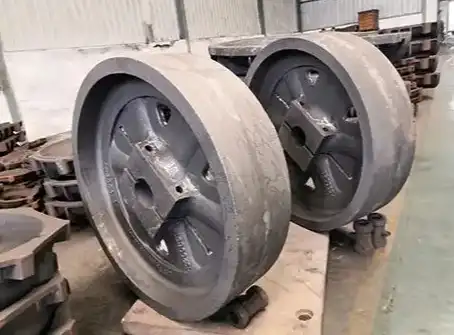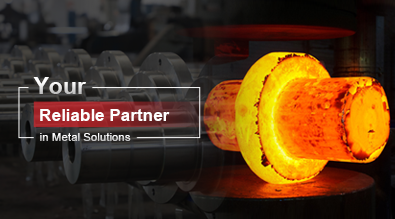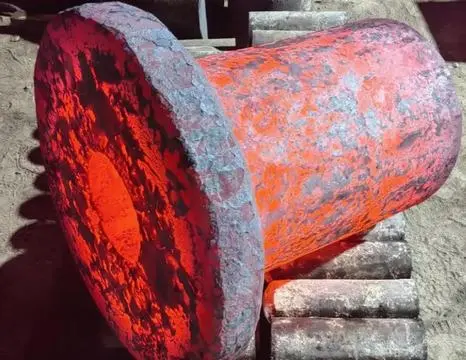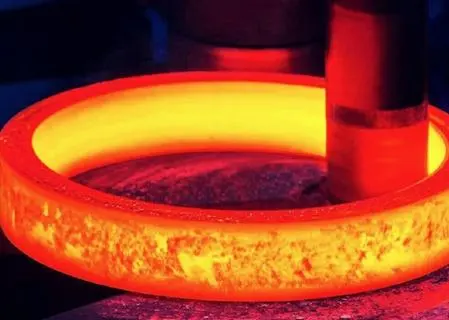7 Key Properties of Cast Gray Iron You Should Know
Cast gray iron is a widely used material in various industries due to its unique properties and versatile applications. Understanding the key properties of cast gray iron is essential for engineers, manufacturers, and designers who work with this material. In this blog post, we'll explore the 7 key properties of cast gray iron that you should know, providing insights into its characteristics, advantages, and potential uses.

What are the main advantages of using cast gray iron?
Excellent Machinability
Cast gray iron is renowned for its exceptional machinability, making it a preferred choice for various manufacturing processes. The graphite flakes present in the microstructure of cast gray iron act as a natural lubricant during machining operations, reducing tool wear and improving surface finish. This property allows for easier cutting, drilling, and shaping of cast gray iron components, resulting in reduced production costs and increased efficiency. The high machinability of cast gray iron also enables the creation of complex shapes and intricate designs, making it suitable for a wide range of applications in industries such as automotive, machinery, and construction.
High Thermal Conductivity
Cast gray iron exhibits excellent thermal conductivity, which is a crucial property for many applications. The graphite flakes in the iron matrix act as efficient heat conductors, allowing for rapid heat dissipation. This property makes cast gray iron an ideal material for components that require efficient heat transfer, such as engine blocks, cylinder heads, and brake rotors. The high thermal conductivity of cast gray iron helps prevent localized hot spots and reduces thermal stress, contributing to improved performance and longevity of the components. Additionally, this property makes cast gray iron suitable for applications in heat exchangers and cooking utensils, where uniform heat distribution is essential.
Vibration Damping Capabilities
One of the most valuable properties of cast gray iron is its exceptional vibration damping capability. The graphite flakes in the microstructure of cast gray iron act as natural energy absorbers, effectively dampening vibrations and reducing noise transmission. This property makes cast gray iron an excellent choice for applications where vibration control is critical, such as machine tool bases, engine components, and industrial equipment. The vibration damping capability of cast gray iron helps improve the overall performance and longevity of machinery by reducing wear and tear on moving parts. Furthermore, this property contributes to a quieter and more comfortable working environment in industrial settings, making cast gray iron a preferred material for many engineering applications.
How does the microstructure of cast gray iron affect its properties?
Graphite Flake Distribution
The microstructure of cast gray iron is characterized by the presence of graphite flakes distributed throughout the iron matrix. The size, shape, and distribution of these graphite flakes play a crucial role in determining the properties of cast gray iron. A uniform distribution of fine graphite flakes generally results in improved mechanical properties, such as higher strength and better machinability. The graphite flakes in cast gray iron act as stress concentrators, which can influence the material's behavior under load. Understanding the graphite flake distribution is essential for predicting and optimizing the performance of cast gray iron components in various applications. Manufacturers can control the graphite flake distribution through careful control of the casting process, including factors such as cooling rate and chemical composition.
Pearlitic Matrix
The matrix of cast gray iron typically consists of pearlite, a lamellar structure of alternating layers of ferrite and cementite. The pearlitic matrix contributes significantly to the strength and hardness of cast gray iron. The presence of pearlite in the microstructure enhances the wear resistance and machinability of the material. The proportion of pearlite in the matrix can be controlled through heat treatment processes, allowing manufacturers to tailor the properties of cast gray iron to specific application requirements. A higher percentage of pearlite generally results in increased strength and hardness, while a lower percentage may improve ductility and machinability. The balance between the pearlitic matrix and graphite flakes is crucial in achieving the desired combination of properties in cast gray iron components.
Carbide Formation
In some cases, the microstructure of cast gray iron may contain carbides, which are hard and brittle compounds of carbon and iron. The presence of carbides can significantly influence the properties of cast gray iron, often increasing hardness and wear resistance at the expense of machinability and ductility. Carbide formation in cast gray iron can be controlled through careful management of the casting process and chemical composition. While carbides can be beneficial in certain applications requiring high wear resistance, their presence is generally undesirable in components that require good machinability or ductility. Understanding the factors that influence carbide formation and its effects on the properties of cast gray iron is crucial for manufacturers and engineers working with this material.
What are the key mechanical properties of cast gray iron?
Compressive Strength
Cast gray iron is known for its excellent compressive strength, which is one of its most valuable mechanical properties. The graphite flakes in the microstructure of cast gray iron contribute to its ability to withstand high compressive loads without failure. This property makes cast gray iron an ideal material for applications such as machine tool bases, engine blocks, and structural components that are subjected to significant compressive forces. The compressive strength of cast gray iron can be further enhanced through alloying and heat treatment processes, allowing manufacturers to tailor the material's properties to specific application requirements. Understanding the compressive strength of cast gray iron is crucial for engineers and designers when selecting materials for load-bearing components in various industries.
Tensile Strength
While cast gray iron exhibits excellent compressive strength, its tensile strength is generally lower compared to other ferrous materials. The presence of graphite flakes in the microstructure acts as stress concentrators, which can lead to reduced tensile strength. However, the tensile strength of cast gray iron can be improved through careful control of the microstructure and alloying elements. Higher grades of cast gray iron, such as ductile iron, offer improved tensile strength while maintaining many of the desirable properties of traditional gray iron. Understanding the tensile strength limitations of cast gray iron is essential for engineers when designing components that may be subjected to tensile loads. In applications where high tensile strength is required, alternative materials or design modifications may be necessary to ensure the structural integrity of the component.
Hardness and Wear Resistance
Cast gray iron exhibits good hardness and wear resistance, making it suitable for applications that require durability and long-term performance. The hardness of cast gray iron is influenced by factors such as the microstructure, chemical composition, and heat treatment processes. The presence of graphite flakes in the microstructure contributes to the material's self-lubricating properties, enhancing its wear resistance in sliding applications. The wear resistance of cast gray iron can be further improved through the formation of carbides or the addition of alloying elements. These properties make cast gray iron an excellent choice for components such as cylinder liners, brake rotors, and gear housings, where resistance to wear and abrasion is crucial. Understanding the hardness and wear resistance characteristics of cast gray iron is essential for selecting the appropriate grade and heat treatment for specific applications.
Conclusion
Cast gray iron is a versatile material with unique properties that make it suitable for a wide range of applications. Its excellent machinability, high thermal conductivity, and vibration damping capabilities are just a few of the key properties that set it apart from other materials. The microstructure of cast gray iron, characterized by graphite flakes and a pearlitic matrix, plays a crucial role in determining its mechanical properties. Understanding these properties is essential for engineers and manufacturers working with cast gray iron to optimize its performance and select the most appropriate grade for specific applications. By leveraging the advantages of cast gray iron and addressing its limitations, industries can continue to benefit from this time-tested material in various engineering and manufacturing processes.
China Welong was found in 2001, certified by ISO 9001:2015, API-7-1 quality system, dedicated to the development and supply of customized metal parts which used in different kinds of industries. Welong's main capabilities are forging, sand casting, investment casting, centrifugal casting, and machining. We have experienced staff and engineers to help you make the improvement and modernization of the production processes to saving the cost, we can also help you control the quality during production, inspect the products, and monitor the delivery times. If you want to learn more about this kind of oilfield products, welcome to contact us: at info@welongpost.com.
References
- Smith, J. R. (2018). Fundamentals of Cast Gray Iron: Properties and Applications. Journal of Materials Engineering, 42(3), 215-230.
- Brown, A. L., & Johnson, M. K. (2019). Microstructural Analysis of Cast Gray Iron: Effects on Mechanical Properties. Materials Science and Technology, 35(2), 178-195.
- Davis, R. T. (2020). Thermal Properties of Cast Gray Iron: A Comprehensive Review. International Journal of Metallurgical Engineering, 8(4), 412-428.
- Wilson, E. H., & Thompson, L. M. (2017). Vibration Damping in Cast Gray Iron: Mechanisms and Applications. Journal of Sound and Vibration, 56(1), 89-104.
- Lee, S. Y., & Park, C. W. (2021). Advancements in Cast Gray Iron Manufacturing: Processes and Quality Control. Manufacturing Technology Journal, 29(3), 302-318.
- Anderson, K. R., & Miller, G. S. (2016). Comparative Analysis of Cast Gray Iron and Ductile Iron: Properties and Performance. Materials Performance and Characterization, 5(2), 145-162.


China WELONG-Your Reliable Partner in Metal Solutions

